-
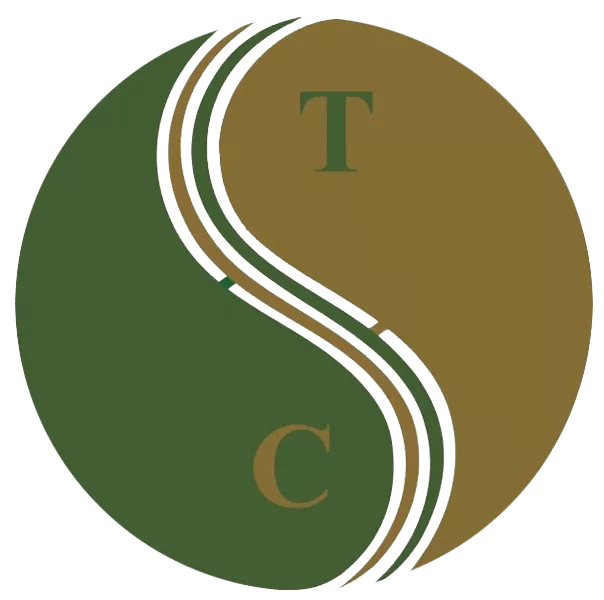 Art of Wellness Acupuncture & Traditional Chinese Medicine (TCM)11704 Wilshire Blvd, Suite 295, Los Angeles, CA, 90025
Art of Wellness Acupuncture & Traditional Chinese Medicine (TCM)11704 Wilshire Blvd, Suite 295, Los Angeles, CA, 90025
myartofwellness@gmail.com310-451-5522 Office Hours
MonClosedTue7:30 am --4 pmWed7:30 am --4 pmThu7:30 am -- 4 pmFri7:30 am -- 4 pmSat7:30 am -- 4 pmSunClosedOur office opens from Tuesdays to Saturdays 7:30 am to 4 pm, will be closed on Memorial day, Independent day, Labor day, Thanksgiving day, Christmas and New year.
-
Recent Posts
- Chinese New Year 2026: Year of the Horse
- Acupuncture and TCM Treatment for Perimenopause Symptoms
- How to Treat Insulin Resistance With Acupuncture and TCM
- How to Treat Metabolic Syndrome With Acupuncture and TCM
- How to Treat Syncope With Acupuncture and TCM
- How to Treat Thoracic Outlet Syndrome With Acupuncture and TCM
- How to Treat Dupuytren’s Contracture With Acupuncture and TCM
- How to Treat Nutcracker Syndrome With Acupuncture and TCM
- How to Treat Rosacea With Acupuncture and TCM
- How to Treat Perioral Dermatitis With Acupuncture and TCM
- Lymphatic Drainage With Acupuncture and TCM
- How to Treat Turf Toe With Acupuncture
- How to Treat Nerve Pain With Acupuncture and TCM
- How to Treat Watery Eyes With Acupuncture and TCM
- How to Treat Ovarian Cysts With Acupuncture and TCM
- How to Treat Dystonia With Acupuncture and TCM
- Sign up to receive news and updates and get my free report:“The Top 10 Reasons to Try Acupuncture”

November 2025 M T W T F S S 1 2 3 4 5 6 7 8 9 10 11 12 13 14 15 16 17 18 19 20 21 22 23 24 25 26 27 28 29 30
Sports injury
How to Treat Thoracic Outlet Syndrome With Acupuncture and TCM
By Qineng Tan, L.Ac., Ph.D. and Xiaomei Cai, L.Ac., Ph.D.
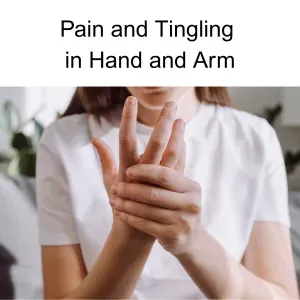
Tingling in one arm? Stiff neck and shoulder? Neck pain or headache back of head? These can be symptoms of thoracic outlet syndrome (TOS), or compression of the nerves and blood vessels that run through the neck and shoulder. Acupuncture and TCM offer thoracic outlet treatment to help relieve pain and numbness in the arm and hand.
Tingling pain and weakness in the arm and hand are the most common signs of thoracic outlet compression syndrome. You might wake up with pins and needles in your arm, or have a feeling of weakness in your hand after lifting things overhead or working for long hours at your computer.
What Causes Thoracic Outlet Syndrome?
There is a narrow space between your top rib and your collarbone, known as the thoracic outlet, through which a complex network of nerves and vessels run, connecting the neck and shoulder to the arm.
These nerves and arteries can become constricted due to tight or misaligned muscles (particularly the scalene or pectoralis minor), poor posture, or repetitive movements at work or while participating in a sport, resulting in impaired circulation, and nerve irritation.
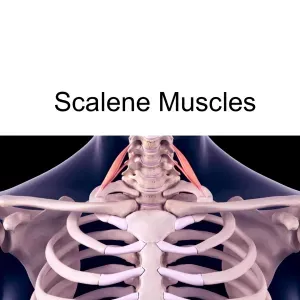
The three scalene muscles (anterior, middle, and posterior) attach the cervical vertebrae of the neck to the top two ribs. Key blood vessels (the brachial plexus, subclavian artery and vein) run through the narrow space between the scalene muscles. When these muscles become tight or pushed out of their proper alignment, this can cause compression or entrapment of the blood vessels, affecting blood flow and sometimes also putting pressure on the ulnar nerve, which extends from the neck all the way down to the hand.
Injury or trauma to the area due to a car accident (such as whiplash) could lead to thoracic outlet syndrome. Sports injuries or simply the repetitive movements involved in a sport could cause thoracic outlet syndrome to develop, particularly movements where the arm is extended above the head, as in swimming or baseball. Physical changes that occur during pregnancy and affect the posture can also aggravate nerves and blood vessels.
People with Ehlers-danlos syndrome may be more prone to developing thoracic outlet syndrome because of instability in the shoulder girdle.
In rare cases, a person might have an extra rib or other anatomical variation, which can contribute to TOS.
Top 10 Symptoms of Thoracic Outlet Syndrome
Symptoms of thoracic outlet compression syndrome can come and go and change over time. Common signs include: tingling and numbness in ring finger or pinky finger, pain in neck, pain in shoulder blade, soreness in the armpit or front of chest.
Common symptoms of thoracic outlet:
- Tingling, numbness, or a “pins and needles” sensation in the arm or hand
- Feeling of fatigue in the arm, or arm feels heavy
- Weakness in the hand grip or difficulty lifting objects, loss of fine motor skills in the hand, clumsiness, dropping things
- Aching pain or tenderness and sensitivity in the neck, shoulder, collarbone or chest, sometimes radiating down the arm
- Shoulder appears to be drooping, slumped posture
- Swelling, discoloration, and/or a sensation of cold in the affected arm or hand
- Headaches, especially pain in the back of the head, headache at the base of the skull
- Loss of muscle in the base of the thumb
- Weak pulse in the affected arm
- Blood clots or deep vein thrombosis
Symptoms like tingling and weakness of the arm and hand usually become worse after the arm has been in an elevated position, performing activities that require the arm to be raised over the head.
Signs of thoracic outlet syndrome can appear similar to those of other conditions, like carpal tunnel syndrome, cubital tunnel syndrome, cervical radiculopathy, or other cervical spine issues. Some of the symptoms of thoracic outlet syndrome are also similar to the symptoms of a heart attack.
Typical Thoracic Outlet Syndrome Therapies
Diagnosis of TOS generally begins with a detailed medical history and physical exam, in which maneuvering the arm or neck rotation may reproduce symptoms. Imaging tests such as X-rays, MRI, CT scans, or Doppler ultrasound help assess anatomical contributors and vascular involvement. Nerve conduction studies can also confirm nerve compression.
Conventional treatment for thoracic outlet syndrome typically starts conservatively. A central focus is on physical therapy, aimed at stretching tight muscles, improving posture, and strengthening supportive muscle groups. Pain may be managed with medications like NSAIDs or muscle relaxants. If symptoms persist or worsen, interventions such as targeted injections (e.g., botulinum toxin into tight scalene muscles) or surgical options (like first-rib resection) may be suggested.
These methods can offer relief, especially when implemented early. Still, recovery can be prolonged and some patients may experience recurring symptoms. Acupuncture and TCM offer alternative management for thoracic outlet syndrome.
Can Acupuncture Help Thoracic Outlet Syndrome?
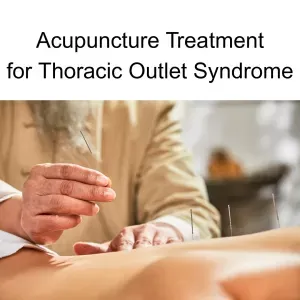
In Traditional Chinese Medicine, thoracic outlet syndrome is viewed as a problem of Qi (energy) and blood stagnation within the meridians that traverse the neck and shoulders, especially the Liver, Gallbladder, and Lung channels. Emotional stress, poor posture, or physical strain may disrupt the smooth flow of Qi, leading to obstructions that manifest as pain, numbness, or movement difficulty.
Additional contributing factors may include Wind-Cold-Damp invasion, which contracts muscles; Liver Qi stagnation, which impairs flexibility; and Spleen or Kidney weakness, which fails to support the body’s structural integrity and recovery.
TCM addresses both the symptomatic blockage and the deeper systemic imbalances underlying the condition.
TCM Treatment for Thoracic Outlet Syndrome
TCM takes a multi-dimensional approach to treating TOS. Acupuncture uses fine needles to stimulate key points that encourage the release of stagnant Qi and improve blood flow.
Cupping and Gua Sha techniques help soften fascia, reduce muscle tension, and encourage lymphatic and blood circulation.
Herbal formulas may include herbs that invigorate blood, relax sinews, and strengthen muscles and fascia.
Lifestyle changes, emphasizing improved posture, ergonomic adjustments, mindful movement, stress management, and dietary tips can help reduce inflammation and support healing.
Controlled trials and case studies suggest acupuncture effectively reduces pain and improves function in conditions involving neurovascular compression. For instance, a controlled study published in 2019 reported significant decreases in pain and disability among patients receiving acupuncture for TOS symptoms.
Another case study found that acupuncture combined with TCM herbal therapy provided thoracic outlet syndrome relief by alleviating shoulder tightness, restoring flexibility, and reducing numbness.
Several clinical groups are exploring acupuncture-mediated modulation of microcirculation, inflammatory markers, and nerve conduction—underscoring its role as a promising complement to standard care.
Acupuncture Near Me for Thoracic Outlet Syndrome in West Los Angeles
TCM modalities are excellent for helping to relieve pain and tingling and improving range of motion for a wide variety of conditions. Acupuncture can provide symptom relief and fundamental improvement of conditions like nutcracker syndrome, carpal tunnel syndrome, cubital tunnel, syndrome, nerve pain, shoulder pain, neck pain, and thoracic outlet syndrome. Drs. Tan and Cai at Art of Wellness in Santa Monica/West Los Angeles have over 35 years of experience in treating vascular and nerve conditions.
*This article is for education from the perspective of Traditional Chinese Medicine only. The education provided by this article is not approved by FDA to diagnose, prevent, treat and cure human diseases. It should not stop you from consulting with your physician for your medical conditions. Traditional Chinese Medicine is based on Qi, which is an invisible force that usually cannot be observed by modern science. Because science focuses on testing ideas about the natural world with evidence obtained through observation, these aspects of acupuncture can’t be studied by science. Therefore acupuncture and Chinese herbs are often not supported by double-blind, randomized trials, and they are considered alternative medicine therapies in the United States.
Plantar Fasciosis Treatment With Acupuncture and TCM
By Qineng Tan, L.Ac., Ph.D. and Xiaomei Cai, L.Ac., Ph.D.
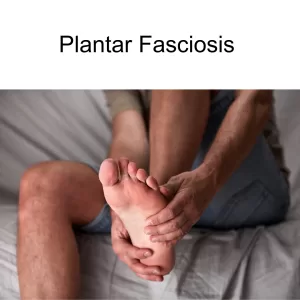
Foot arch pain? Ache in the bottom of the foot or heel? This condition has commonly been known as plantar fasciitis, but now more practitioners are calling it “plantar fasciosis.” Acupuncture treatment can help relieve arch and foot pain and get you walking comfortably again.
What Is Plantar Fasciosis?
The plantar fascia ligament connects the heel bone to the toes, spanning the whole bottom of the foot. It absorbs shock every time your foot touches the ground, as you walk.
When this band of connective tissue starts to cause you pain, it’s usually due to overuse, overstretching, or wearing shoes that don’t give you enough support and cushioning.
This condition, which is the most common cause of heel pain and pain in the bottom of the foot, has been called “plantar fasciitis” for some time, because it was believed to be caused by inflammation in the connective tissue. The suffix “-itis” means “inflammation,” as in “tendinitis,” “pancreatitis,” and many other health conditions that are related to inflamed tissues.
If the bottom of the foot shows signs of swelling, warmth, and redness, then it is probably related to inflammation.
However, many cases of plantar fascia pain are not caused by inflammation. Sometimes, arch pain is due to a degenerative condition, in which the tissues are breaking down. Microtears in the connective tissues, or cell death, because of lack of blood flow, are often the real problems causing the pain.
Symptoms of Plantar Fasciosis
Arch and foot pain when you first get up in the morning is one of the most common signs of plantar fasciitis or plantar fasciosis. This pain can be sharp and stabbing, or more of a dull ache.
Often, walking or exercise makes the foot feel better for a while, but then, after you sit down and rest, and then get back up, the pain flares up again.
The signs that you may have damage in your plantar fascia include:
- Pain in the heel of your foot
- Sore foot arch or foot arch tenderness
- Stiffness in the foot
- Tight Achilles tendon
- Swelling around the heel
Why Does the Bottom of My Foot Hurt?
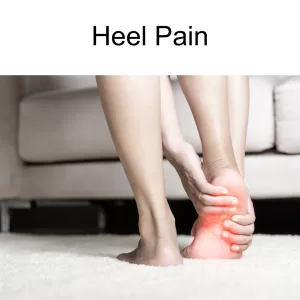
Lots of activities can cause damage to the sensitive connective tissue in the bottom of your foot. Some of the causes of plantar fasciosis include:
- Standing for long periods of time
- Working out, dancing, or just walking on a hard surface (like a concrete floor or sidewalk)
- Exercising without stretching or warming up your feet and leg muscles
- Wearing shoes with little support, like sandals or flat sneakers
- Walking around barefoot a lot (even at home)
You might be more susceptible if your arches are very high, or if your feet don’t have much of an arch at all. You may also be at higher risk for foot pain if you are carrying a lot of extra weight.
Conditions like rheumatoid arthritis or psoriatic arthritis can also contribute to the development of plantar fasciosis.
Plantar Fasciosis Treatment
Typically, a doctor does not even need to perform any special diagnostic testing to conclude that a person is experiencing plantar fasciitis, or “heel spur syndrome.”
A treatment protocol typically includes some stretching exercises, the use of orthotics, OTC pain medications, and possibly corticosteroid injections.
Rest and patience, and a gradual increase of physical activity are usually recommended.
Acupuncture treatment can help by relieving pain and helping to promote healing in the damaged tissues.
Can Acupuncture Help Plantar Fasciosis/Plantar Fasciitis?
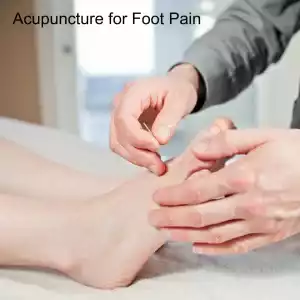
TCM takes a holistic approach to treating pain conditions and sports injuries. From the TCM perspective, trauma to the plantar fascia area can lead to stagnation and deficiency in the flow of Qi and blood.
Acupuncture, Tuina massage, and gua sha are all TCM modalities that can help improve blood flow and promote healing.
Pain sensations stem from injury and damage to bodily tissues, but the pain signals themselves are controlled by the central nervous system and brain activity. Acupuncture has been shown to have effects that can calm down this signalling, which can alter how a person experiences feelings of pain.
Medical science is still conducting research to understand how it is that acupuncture treatment works effectively to reduce and relieve pain.
The action and “excitability” of neurons in the hypothalamus are related to pain sensations. It has been suggested that acupuncture treatment may help to change the excitability of the neurons, thus changing the perception of pain.
It has also been suggested that pain in the plantar fascia is related to the activation of trigger points in the muscles of the foot. Electro-acupuncture can help “deactivate” these trigger points to relieve pain.
Acupuncture needling may affect nerve endings in the local area that release vasoactive neuropeptides, which play a key role in blood flow to an area and the release of hormones. It may also reduce electrical activity, or the “twitch” response in muscle tissues.
Acupuncture can also increase the levels of endorphins, serotonin, and noradrenaline released by the body’s own pain relief system, and help to decrease the number of pain signals that are being sent through the central nervous system.
One study compared patients who were given exercises to help with their plantar fasciopathy versus patients who did the exercises and were given acupuncture treatment. The exercise-only group experienced an overall 21% reduction of their pain scores, while the acupuncture group reported a greater than 50% reduction in pain right after the treatments.
How to Help Plantar Fasciosis Pain
Here are a few important tip for how to help heal and prevent foot pain from coming back.
- Wear shoes with a wide toe box and flat heels (not high heels). Be sure to replace your shoes as needed; the cushioning foam in shoes breaks down, even if you haven’t been wearing them often.
- Wearing toe spacers that help create more space around your toes can help by reducing the constriction of blood vessels and getting more blood flow to your whole foot.
- A warm foot bath every night before bedtime, especially with Chinese herbs or Epsom salt, is very helpful for circulation, which is essential for healing damaged connective tissue.
- Warm up properly before your workout, and vary your workouts, so that you are not just engaging in the same repetitive actions every time you exercise.
- Avoid running and walking on concrete surfaces, and avoid exercising outdoors when it is damp, rainy, and cold.
Acupuncture Near Me for Plantar Fasciosis in West Los Angeles
Plantar fasciosis pain can get in the way of your daily exercise routine and make walking painful for months, if you don’t take proper care of it. The right combination of gentle exercise, acupuncture treatment, herbs and nutrition can help you get back to walking normally without pain more quickly. If you are feeling that pain in the bottom of your foot every morning when you get out of bed, please consider coming and seeing Dr. Tan or Dr. Cai to help relieve heel pain.
*This article is for education from the perspective of Traditional Chinese Medicine only. The education provided by this article is not approved by FDA to diagnose, prevent, treat and cure human diseases. It should not stop you from consulting with your physician for your medical conditions. Traditional Chinese Medicine is based on Qi, which is an invisible force that usually cannot be observed by modern science. Because science focuses on testing ideas about the natural world with evidence obtained through observation, these aspects of acupuncture can’t be studied by science. Therefore acupuncture and Chinese herbs are often not supported by double-blind, randomized trials, and they are considered alternative medicine therapies in the United States.
How to Treat Wrist Pain With Acupuncture and TCM
By Qineng Tan, L.Ac. Ph.D. and Xiaomei Cai, L.Ac., Ph.D.
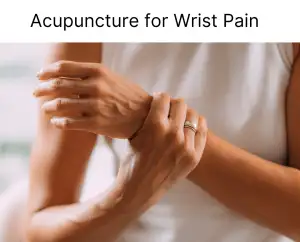
Wrist pain when you bend it? Is it hard to open jars or doors? Popping sound in wrist? Pain at the base of the thumb? Wrist or fingers swollen? Wrist pain can be caused by a variety of joint issues, including tendinitis of wrist, or De Quervain’s tenosynovitis. Acupuncture and TCM can help treat the root cause of wrist pain.
The wrist is a complex joint composed of several small bones, tendons, ligaments, muscles, and nerves. In medical terminology, the thumb side of the wrist is the radial wrist (wrist pain on thumb side, radial thumb pain, or inner wrist pain), while the little finger side is the ulnar wrist (wrist pain on pinky side, ulnar wrist pain, or outer wrist pain).
Injuries, such as a wrist fracture, are a particularly common cause of acute wrist pain, as people will often try to catch themselves with an outstretched hand when falling, which can easily lead to wrist injury. Wrist fractures can result in wrist pain, swelling, bruising, and an inability to move the wrist normally.
Fractures may also damage nearby ligaments, nerves, and tendons, which can complicate healing and prolong discomfort. Proper alignment and stabilization are essential for healing, and if not treated correctly, a fracture can lead to chronic pain and arthritis in the wrist.
Acupuncture treatment can certainly be helpful for reducing inflammation, relieving acute pain, and helping to speed the healing of a wrist fracture.
Other, more chronic conditions can also cause wrist pain.
Top 5 Causes of Wrist Pain
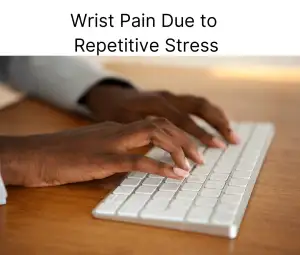
Certain chronic health conditions that build up slowly over time can ultimately lead to wrist pain and dysfunction. Some of these include:
- Arthritis of the Wrist – Osteoarthritis of the wrist and rheumatoid arthritis can both be causes of wrist pain. Osteoarthritis is typically caused by wear and tear on the cartilage of the wrist joint. This condition usually develops slowly over time, especially in individuals who have experienced previous injuries or repetitive stress on the wrist. Rheumatoid arthritis is an autoimmune condition that causes inflammation of the wrist joints, leading to pain, warmth, and eventual joint damage. Both types of arthritis can severely limit the range of motion and strength in the wrist, making even simple activities painful.
- Repetitive Stress Injury (RSI) – Repetitive stress injuries in the wrist are caused by continuous or repetitive movements, such as typing, gripping, or lifting, which can strain the tendons and ligaments in the wrist. Over time, this repetitive strain can lead to inflammation, pain, and decreased mobility. Carpal tunnel syndrome and tendonitis (discussed further below) are common forms of repetitive strain injury that cause wrist pain. RSI often requires rest and modification of activities to allow the wrist to heal, as continuous stress can worsen the condition and lead to long-term issues.
- De Quervain’s Tenosynovitis – De Quervain’s tenosynovitis (also known as Quervain disease or styloid tenosynovitis) affects the tendons on the thumb side of the wrist. It occurs when the tendons around the base of the thumb become inflamed, leading to pain and tenderness, particularly during movements that involve gripping or pinching. This condition is often the result of repetitive thumb movements, such as those used in typing or texting. De Quervain’s disease tenosynovitis can cause sharp pain on the radial (thumb) side of the wrist, and people may find it difficult to grasp or hold objects.
- Tendonitis (or Tendinitis) of the Wrist – Tendonitis of the wrist refers to inflammation of the tendons that cross the wrist joint. It is commonly caused by repetitive motion, excessive strain, or sudden injury. Tendonitis can affect various tendons depending on the type of movement that led to the condition. Pain and swelling are typical symptoms, and the affected area may feel warm to the touch. Wrist tendonitis is often seen in athletes and individuals who perform repetitive tasks with their hands and can result in decreased wrist function and grip strength.
- Carpal Tunnel Syndrome – Carpal tunnel syndrome is a type of neuropathy, or nerve pain, caused by compression of the median nerve as it passes through the carpal tunnel in the wrist. This compression leads to pain, tingling, numbness, and weakness in the hand and wrist. Carpal tunnel syndrome is often associated with repetitive wrist movements and can be exacerbated by activities that involve gripping or bending the wrist. If left untreated, carpal tunnel syndrome can lead to permanent nerve damage and reduced hand function.
Other possible causes of wrist pain could include: bursitis (small, fluid-filled sacs that form between bones), ganglion cysts (fluid-filled cysts that form near joints), or Kienbock’s disease (in which the lunate bone of the wrist begins to break down).
Treatment for Wrist Pain
When a patient presents with wrist pain, diagnosis usually begins with a physical examination to identify the specific cause of pain. The doctor will assess the patient’s range of motion, grip strength, and any areas of tenderness or swelling in the wrist. Imaging via X-rays, MRI or ultrasound may be used to confirm a diagnosis, especially if a fracture, ligament tear, or nerve compression is suspected.
For nerve-related issues like carpal tunnel syndrome, a nerve conduction study (NCS) or electromyography (EMG) may be conducted to assess the functionality of the median nerve. This can help differentiate between arthritis, repetitive strain injuries, or specific tendon and nerve issues.
Conventional treatments for wrist pain depend on the specific diagnosis. In cases of arthritis, anti-inflammatory medications (NSAIDs), corticosteroid injections, or physical therapy are commonly recommended to manage pain and improve joint mobility.
For fractures, immobilization with a cast or splint is typically required, and surgery may be necessary for more severe breaks. Repetitive stress injuries like tendonitis or De Quervain’s tenosynovitis often respond to rest, ergonomic modifications, and anti-inflammatory treatments.
Physical therapy exercises to strengthen and stretch the affected muscles and tendons can be helpful. In cases of carpal tunnel syndrome, wrist splints are often used to keep the wrist in a neutral position, particularly at night, and corticosteroid injections may be administered, aimed to reduce inflammation.
If these methods do not relieve symptoms, surgical intervention, such as carpal tunnel release, might be recommended to decompress the median nerve.
While typical treatment usually involves pain medication, rest, and possibly physical therapy, acupuncture treatment can be an excellent adjunct or alternative treatment to relieve wrist pain.
Can Acupuncture Help Wrist Pain?
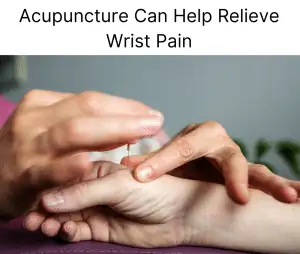
Acupuncture and Traditional Chinese Medicine (TCM) can offer natural pain relief for injuries and chronic pain conditions, by reducing pain and inflammation, improving circulation, and supporting the body’s healing process.
According to TCM theory, the health of the internal organ systems is related to the rest of the body parts. For example, the spleen is responsible for transforming Qi and blood. If the spleen is weak, it can cause blockages in blood flow that create stasis, stiffness and pain in the limbs and joints. The liver governs the tendons of the body. When the liver is not functioning well, often due to emotional stress, than there may be pain and dysfunction in the tendons and joints.
Therefore, an acupuncturist does not only treat the painful area, but also looks at the deeper root cause and addresses them with acupuncture treatment, Chinese herbs, and other therapeutic modalities, to help relieve pain and inflammation and bring about healing.
A systematic review of trials showed that acupuncture treatment led to significant pain reduction for patients treated for rheumatoid arthritis affecting the wrist. It also concluded that acupuncture brought about pain relief and functional improvement for patients with tenosynovitis and carpal tunnel syndrome.
One study separated patients with carpal tunnel syndrome into two groups: one group received pain medication for wrist pain and the other group had 12 acupuncture treatments. Comparatively, the acupuncture group had greater reduction in pain, tingling, and numbness and greater functional improvement.
Studies of MRI results after acupuncture have suggested that acupuncture for carpal tunnel syndrome actually has a positive impact on nerve function in the wrist and changes the way the brain and nerves are signaling pain.
A trial involving patients treated for De Quervain’s disease tenosynovitis with five acupuncture sessions over the course of two weeks showed improvement in pain and grip strength, and the results were still maintained at a ten week follow up visit.
The combination of acupuncture and moxibustion can be particularly helpful for treating Quervain’s tenosynovitis.
Overall, the evidence shows that acupuncture and other TCM modalities can be a relatively low cost, non-invasive way of helping to treat wrist pain, without surgery or the unwanted side effects of pain medications or steroid injections.
Acupuncture Near Me for Wrist Pain in Los Angeles
Dr. Tan and Dr. Cai at Art of Wellness in West L.A. have over 35 years of experience helping people recover from sports injuries, repetitive stress injuries, and orthopedic pain conditions of all kinds. Acupuncture treatment for wrist pain can be used in addition to your medical protocol to help speed recovery and bring about pain relief.
*This article is for education from the perspective of Traditional Chinese Medicine only. The education provided by this article is not approved by FDA to diagnose, prevent, treat and cure human diseases. It should not stop you from consulting with your physician for your medical conditions. Traditional Chinese Medicine is based on Qi, which is an invisible force that usually cannot be observed by modern science. Because science focuses on testing ideas about the natural world with evidence obtained through observation, these aspects of acupuncture can’t be studied by science. Therefore acupuncture and Chinese herbs are often not supported by double-blind, randomized trials, and they are considered alternative medicine therapies in the United States.
How to Treat Bone Spurs With Acupuncture and TCM
By Qineng Tan, L.Ac., Ph.D. and Xiaomei Cai, L.Ac., Ph.D.
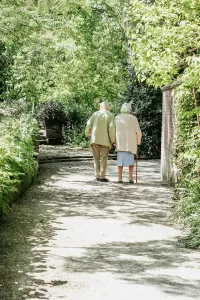
Heel pain when walking? Numbness in arms or legs? Hip pain? These can all be signs of bone spurs, or osteophytes—bony projections that develop around joints or along the spine. Acupuncture and TCM can help alleviate pain and tingling related to heel spurs and bone spurs on spine,and help to prevent further growth of bone spurs.
Bone spurs are essentially extra bone tissue that grows around the edges of bones. This happens most commonly where two different bones meet in a joint. Bone spurs can grow in many areas: knees, hips, bone spurs on feet, shoulder, ankle, or bone spur in back.
What Is the Root Cause of Bone Spurs?
Osteoarthritis is a degenerative condition that causes cartilage to wear down over time. Sometimes bone spurs develop as the body’s way of making up for loss of cartilage in a particular area, trying to fill in the gap.
Bone spurs can also grow due to pressure on a bone, which can either be due to repetitive stress from movement (sports, dancing, etc.), extra weight because of obesity, or wearing shoes that rub or pinch the heel or top of the foot.
Maybe you’ve noticed foot spurs on heel. Heel spurs often relate to plantar fasciitis—inflammation in the ligaments of the foot that causes heel pain. Bone spur heel can develop as the body’s reaction to plantar fasciitis, causing sharp pain in the foot.
You might feel a lump or bump growing on the top of your foot or on one of your toes. Bone spurs in foot or heel are very common, especially as people age. The older you are, the higher your risk of developing bone spurs.
Having flat feet can also increase the risk of bones spurs on feet, as this condition puts extra stress on the many small bones and joints in your feet.
Osteophytosis of the spine can develop in the neck (cervical spine), mid-back (thoracic spine), or lower back (lumbar spine), potentially causing pain, stiffness, and nerve compression, leading to tingling or numbness in the arms and/or legs.
Bone Spur Symptoms
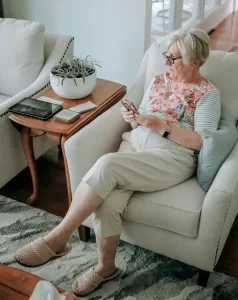
Many people have bone spurs without realizing it, because bone spurs don’t necessarily cause pain. In other cases, bone spurs can cause serious, debilitating pain, making it difficult to walk.
The most common signs of bone spurs include:
- Stiffness
- Redness and swelling around the bone spur
- Stiff joints
- Weakness in limbs
- Tingling or numbness in limbs
- Corns on the toes
- Difficulty standing or walking
Heel Spur Treatment
Bone spurs are typically diagnosed through physical examination and imaging studies, such as X-rays, MRI, or CT scans. These tests help determine the size and location of the bone spur and assess the extent of any associated damage to surrounding tissues, such as cartilage, muscles, or nerves.
Medications like ibuprofen or naproxen are commonly prescribed to reduce pain and inflammation. Corticosteroid injections may also be used to provide temporary relief from pain.
In severe cases, surgical intervention may be recommended. Procedures such as a bone spur removal (osteophyte excision) or joint replacement (in cases of severe osteoarthritis) may be performed. In some cases of heel spurs, this is combined with plantar fascia release surgery.
Most bone spurs, however, do not require surgery. It is possible to relieve pain and pressure caused by bone spurs and prevent them from growing bigger. Acupuncture and TCM can help by addressing the root cause of bone spurs.
Can Acupuncture Help Bone Spurs?
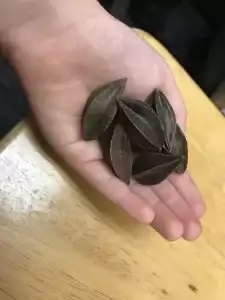
In Traditional Chinese Medicine (TCM), bone spurs are viewed as the result of imbalances within the body, particularly related to deficiencies in the Kidney and Liver organ systems.
What deficiency causes bone spurs?
According to TCM theory, the Kidneys govern the bones and produce marrow, which nourishes the bones. This concept of the “kidney” is very different from the way we think of it in modern medicine; it is more of a functional concept of how water is metabolized in the body, and how it relates to growth, development, and aging. Kidney deficiency can lead to weakened bones and the development of osteophytes.
Herbs that nourish the kidney system will be combined with acupuncture treatment. Specific acupoints can be used to stimulate the parathyroid gland, which plays a role in calcium utilization.
Acupuncture treatment can help provide pain relief for many orthopedic conditions that cause joint pain or bone pain, including tennis elbow, bursitis/hip pain, and arthritis.
One case study of a woman suffering from heel pain that had not resolved with conventional treatments of local steroid injections. After receiving regular acupuncture treatments over a course of six months, the patient reported that her pain had gone from an 8 on the pain scale to a 3. Radiology imaging showed, after the course of acupuncture treatment, that the bone spur was no longer in evidence.
Your TCM practitioner may recommend eating a diet that supports bone health, including foods that are rich in calcium, magnesium, and other essential nutrients. Foods that nourish the Kidneys, such as black beans, walnuts, and seaweed, will usually be emphasized.
Acupuncture Near Me for Bone Spurs in Los Angeles
Acupuncture and Traditional Chinese Medicine provide a holistic and effective way to manage and treat bone spurs. Drs. Tan and Cai at Art of Wellness in West L.A. have over 35 years of experience helping people find relief from bone pain due to all kinds of conditions. Whether you’re dealing with heel spurs, spinal osteophytes, or foot spurs, TCM can be an integral part of your treatment plan, offering a natural and holistic approach to long-term bone health.
*This article is for education from the perspective of Traditional Chinese Medicine only. The education provided by this article is not approved by FDA to diagnose, prevent, treat and cure human diseases. It should not stop you from consulting with your physician for your medical conditions. Traditional Chinese Medicine is based on Qi, which is an invisible force that usually cannot be observed by modern science. Because science focuses on testing ideas about the natural world with evidence obtained through observation, these aspects of acupuncture can’t be studied by science. Therefore acupuncture and Chinese herbs are often not supported by double-blind, randomized trials, and they are considered alternative medicine therapies in the United States.
How to Treat Shin Splints With Acupuncture and TCM
By Qineng Tan, L.Ac., Ph.D. and Xiaomei Cai, L.Ac., Ph.D.
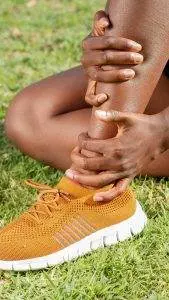
Shin pain, especially during or after exercise? Tenderness and swelling around the shin bone? These may be signs of shin splints, or a shin strain. Acupuncture and TCM can provide shin splints treatment.
Shin splints, also known as medial tibial stress syndrome (MTSS), are a common condition characterized by pain along the inner edge of the shinbone (tibia). This discomfort typically occurs during or after exercise, particularly activities that involve running, jumping, or repetitive stress on the legs.
Shin splints are often attributed to overuse or excessive strain on the muscles, tendons, and bone tissue of the lower leg. This condition involves stress to the soft tissues that causes them to become swollen and hard.
Shin splints pain can be similar to compartment syndrome symptoms, but these are two distinctly different conditions. Compartment syndrome occurs when swelling in the calf area causes a blockage of blood flow to the lower leg. This usually happens due to an injury (acute compartment syndrome) or extreme exertion (chronic exertional compartment syndrome) and causes a severe lack of oxygen in the area. Compartment syndrome usually causes severe pain, sometimes with a tingling or burning sensation, and requires medical attention.
What Causes Shin Splints?
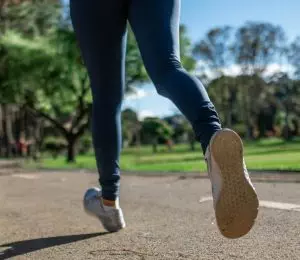
Several factors can contribute to the development of shin splints. One of the primary causes is repetitive stress or overloading of the leg muscles, particularly those responsible for dorsiflexion (lifting the foot upwards) and supporting the arch of the foot. This can occur due to sudden increases in activity level, such as starting a new exercise regimen or intensifying training too quickly, without allowing adequate time for the body to adapt and recover.
Some people may be more prone to developing shin splints because of issues like flat feet, overpronation (excessive inward rolling of the foot), and muscle imbalances in the lower limbs can place additional strain on the shinbone and surrounding soft tissues, increasing the risk of injury.
Wearing footwear with insufficient cushioning or support, running on hard or uneven surfaces, and running downhill or on inclined terrain can all exacerbate the stress on the lower legs and contribute to the development of shin splints. Additionally, factors such as tight calf muscles, weak shin muscles, and not warming up or stretching before exercise can further increase susceptibility to this condition.
Taking care to stretch and warm up before working out, wearing shoes with enough support, and gradually increasing intensity of training can help prevent shin splints.
However, runners and athletes who play basketball or soccer are likely to experience shin splints when they are training and competing.
Shin splints treatment generally requires time and patience. Acupuncture can provide pain relief and help speed recovery from shin splints.
Top 10 Signs and Symptoms of Shin Splints
These signs and symptoms may vary in severity and duration depending on the individual and the underlying causes of shin splints.
- Pain along the inner edge of the shinbone (tibia), typically felt during or after physical activity.
- Tenderness and soreness along the shinbone, especially upon palpation or pressure.
- Swelling or inflammation of the lower leg, often localized to the area of pain.
- Dull, aching pain that may worsen with activity and subside with rest.
- Discomfort that initially occurs at the beginning of exercise but may progress to persist throughout the activity.
- Pain that gradually increases in intensity or becomes more widespread over time.
- Pain that may be accompanied by a feeling of tightness or stiffness in the muscles of the lower leg.
- Pain that persists even after cessation of activity and may interfere with daily activities.
- Possible development of small lumps or bumps along the inner border of the shinbone due to inflammation or irritation of the surrounding tissues.
- Pain that improves with rest but recurs upon resuming physical activity, especially activities that involve impact or weight-bearing on the legs.
Shin Splints Treatment
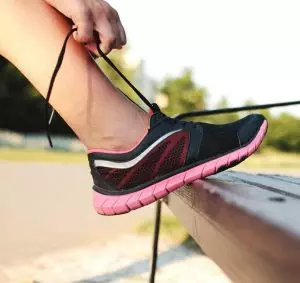
Conventional treatment of shin splints usually involves rest and over the counter pain relief. Typically, a doctor will recommend that a person with shin splints limits their exercise to low-impact activities. Icing the area several times per day is advised.
Acupuncture treatment for medial tibial stress syndrome can help relieve shin pain quickly.
One case study showed that a patient who had been suffering from shin splints for six weeks got pain relief after one session of acupuncture treatment, and at a four week follow, was still pain-free.
Can Acupuncture Help Shin Splints?
Acupuncture treatment helps with the healing of soft tissue injuries by increasing circulation to the area, relieving inflammation, and aiding in the release of endorphins for pain relief. It does this by activating Qi to move blood and energy more efficiently through the body.
One study of three groups of athletes with shin splints looked at patients who received conventional sports medicine, patients who received acupuncture, and patients who received both. The groups who received acupuncture treatment reported significantly lower pain levels and used less NSAIDs than those who did not receive acupuncture.
Acupuncture Near Me for Shin Splints in West Los Angeles
Acupuncture is an effective modality for treating many kinds of repetitive stress injuries and nerve pain conditions, including sprained ankles, Baker’s cyst, tendinitis, and carpal tunnel syndrome. Dr. Tan has over 35 years of experience helping patients find pain relief and improved mobility through treating all kinds of orthopedic and musculoskeletal conditions. While each case is unique, it is possible to get pain relief quickly with TCM treatment, including acupuncture, electro-acupuncture, therapeutic massage like Tui Na, topical herbal patches, and herbal ointments. If you are in pain and need to heal quickly to get back to your regular activities, acupuncture can help.
*This article is for education from the perspective of Traditional Chinese Medicine only. The education provided by this article is not approved by FDA to diagnose, prevent, treat and cure human diseases. It should not stop you from consulting with your physician for your medical conditions. Traditional Chinese Medicine is based on Qi, which is an invisible force that usually cannot be observed by modern science. Because science focuses on testing ideas about the natural world with evidence obtained through observation, these aspects of acupuncture can’t be studied by science. Therefore acupuncture and Chinese herbs are often not supported by double-blind, randomized trials, and they are considered alternative medicine therapies in the United States.